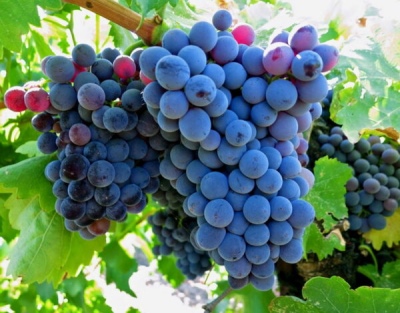
- Authors: Spain
- Appointment: technical
- Berry color: black
- Ripening period: average
- Frost resistance, ° C: -22
- Name synonyms: Grenache Noir, Abundante, Aleante, Alicante, Aragones, Garnacha, Garnacha Tinta, Cannoao, Cannonaddu, Cannonadu and others
- Yield: 20 c / ra
- Density of the bunch: loose to dense
- Skin: thick and dense
- Berry shape: rounded
The technical variety Grenache Noir, also known as Grenache Noir, Alicante, Aragones, Garnacha Tinta, is highly regarded by European winemakers for its abundant harvests and bright juice color. Fragrant berries on bunches contain a significant amount of sugar. The grapes are well blended with the Grenache Blanc and Grenache Gris varieties.
Breeding history
There is no exact information about the selection. Presumably the variety was bred in Spain, in the northern regions of Aragon. It belongs to the group of Western European grapes. The first mention of it dates back to 1513. It was at this time that Garnache was written about in the book Agricultural Labor.
Geography of distribution
Grenache Noir is one of the most widespread varieties around the world. It is actively grown in the northern and southern regions of Spain, in the USA, mainly in the state of California. In the first half of the 20th century, it was actively cultivated in Australia. Often found in vineyards in France and on the Mediterranean coast. In Russia, it can be grown in the Black Sea region.
Description
Medium-sized grapes of this variety are distinguished by early flowering and long ripening of the vine. The bushes form stepchildren in moderation, powerful shoots are confidently held even without support. The root system is well developed, sinks deep into the soil, without experiencing a moisture deficit. The leaves on the bush are compact to medium in size, funnel-shaped, with 3 or 5 lobes. The plate is green, glossy on the front and slightly pubescent on the inside.
Ripening period
This variety is characterized by an average ripening period. The growing season is quite long, the berries can crumble before maturity.
Bunches
The brushes on the bush are conical. The density of the bunch varies from loose to dense.
Berries
Rounded berries have a rich black skin tone with a white prune bloom. The shell is thick and dense, the pulp is juicy inside. The size of the berries is medium.
Taste
The berries meet the taste requirements for technical varieties. Not intended for fresh consumption. The acidity and tannin content varies with growing conditions. In the aroma and taste, connoisseurs find notes of cherry and raspberry, orange peel and spices, and in fruits from Sardinia - hints of tobacco and sage.
Yield
Grenache Noir gives up to 20 c / ha of berries. The variety is high-yielding.


Growing features
The variety is very thermophilic, drought-resistant, does not tolerate high humidity. The best soils for it are stony and shale. It is on them that berries are obtained, suitable for the production of strong, rich rosé and red wines. Due to its low water demand, it is considered the most environmentally friendly variety.
Landing
For growing grapes Grenache Noir choose the southern or western part of the site, well lit by the sun most of the day. The second half of April is selected for planting. Previously, the site for the vineyard is dug up, very dense clay can be diluted with sand. Pits for bushes are prepared with a size of 80 × 80 cm with mandatory drainage of the base, about 1.5 m are left between the neighboring ones.
For planting, plants with a green cut on top and white roots are considered the best choice. When buying a shoot in a container, it is transferred to the soil with a lump of earth. With an open root system, it is better to pre-soak in growth stimulants. Finished seedlings are placed in holes, sprinkled with earth, compacted and watered.

Pollination
No special pollination is needed. The variety copes with it without outside help.
Pruning
Grenache Noir needs the autumn pruning of the mature vine in the lower part of the bush, giving it a fan-shaped shape. So the plants get more strength for wintering and subsequent fruiting. Pruning is performed only after the end of the movement of juices in the shoots.

Watering
The variety is drought tolerant. He needs abundant watering only when planting. The soil must remain dry enough, otherwise the plant will hurt, it may die.


Top dressing
Grapes of this variety need feeding once, in the spring. It also serves as the best disease prevention measure. A mixture of a nitrogen-potassium-phosphorus complex is introduced under the bushes, with the addition of copper and zinc. A combination of 20 g of superphosphate, 10 g of ammonium nitrate, 5 g of potassium salt works well. Substances are diluted in a bucket of water, then used to feed plants.
Frost resistance and the need for shelter
The vine can withstand frosts down to -22 degrees Celsius. In the climate of Spain and regions close to it, it grows without shelter.

Diseases and pests
In dry climates, grapes practically do not get sick. With an increase in air humidity, there may be cases of infection with fungal diseases, usually powdery mildew. Among the pests, the most dangerous for this variety is aphid. Insecticidal treatment will have to be carried out regularly. Ripening berries are kept from wasps with the help of fabric or mesh bags.

If a grape is exposed to any disease or insect, this always affects its appearance.
Storage
Not intended for long-term storage. Recyclable.











































































